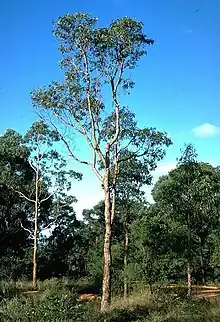| Blackdown yellowjacket | |
|---|---|
 | |
| Corymbia bunites in Blackdown | |
| Scientific classification | |
| Kingdom: | Plantae |
| Clade: | Tracheophytes |
| Clade: | Angiosperms |
| Clade: | Eudicots |
| Clade: | Rosids |
| Order: | Myrtales |
| Family: | Myrtaceae |
| Genus: | Corymbia |
| Species: | C. bunites |
| Binomial name | |
| Corymbia bunites | |
| Synonyms[1] | |
|
Eucalyptus bunites Brooker & A.R.Bean | |
Corymbia bunites, commonly known as Blackdown yellowjacket,[2] is a species of tall tree that is endemic to Queensland. It has rough bark on the trunk and branches, lance-shaped or curved adult leaves, flower buds in groups of seven, white flowers and barrel-shaped, urn-shaped or spherical fruit.
Description
Corymbia bunites is a tree that typically grows to a height of 25 m (82 ft) and forms a lignotuber. It has soft, rough, flaky yellowish or brownish bark on the trunk and branches. Young plants and coppice regrowth have egg-shaped to lance-shaped leaves that are 80–165 mm (3.1–6.5 in) long and 20–35 mm (0.79–1.38 in) wide. Adult leaves are the same shade of green on both sides, lance-shaped or curved, 70–200 mm (2.8–7.9 in) long and 12–35 mm (0.47–1.38 in) wide, tapering to a petiole 10–26 mm (0.39–1.02 in) long. The flower buds are arranged on the ends of branchlets on a branched peduncle 5–25 mm (0.20–0.98 in) long, each branch of the peduncle with seven buds that are sessile or on pedicels up to 4 mm (0.16 in) long. Mature buds are oval, about 7 mm (0.28 in) long and 5 mm (0.20 in) wide with a variably shaped operculum. The flowers are white and the fruit is a woody barrel-shaped, urn-shaped or spherical capsule 8–12 mm (0.31–0.47 in) long and 7–11 mm (0.28–0.43 in) wide with the valves enclosed in the fruit.[2][3][4]
Taxonomy and naming
The Blackdown yellowjacket was first formally described in 1991 by Ian Brooker and Anthony Bean in the journal Austrobaileya and given the name Eucalyptus bunites from specimens collected by Brooker on the Blackdown Tableland in 1972.[4][5] In 1995, Ken Hill and Lawrie Johnson changed the name to Corymbia bunites.[3][6] The specific epithet (bunites) is from an ancient Greek word meaning "hill dweller", referring to the habitat of this species.[4]
Distribution and habitat
Corymbia bunites grows in shallow, sandy soil on sandstone hills and ridges. It has a disjunct distribution, mainly on the Blackdown Tableland but also on the Expedition Dawson, Bedourie and Shotover Ranges.[2][3][4]
Conservation status
This eucalypt is classified as of "least concern" under the Queensland Government Nature Conservation Act 1992.[7]
See also
References
- 1 2 "Corymbia bunites". Australian Plant Census. Retrieved 1 February 2020.
- 1 2 3 "Corymbia bunites". Euclid: Centre for Australian National Biodiversity Research. Retrieved 5 June 2020.
- 1 2 3 Hill, Kenneth D.; Johnson, Lawrence A.S. (13 December 1995). "Systematic studies in the eucalypts. 7. A revision of the bloodwoods, genus Corymbia (Myrtaceae)". Telopea. 6 (2–3): 373–374. doi:10.7751/telopea19953017.
- 1 2 3 4 Brooker, M. Ian H.; Bean, Anthony r. (1991). "A revision of the yellow bloodwoods (Myrtaceae: Eucalyptus ser. naviculares Maiden)". Austrobaileya. 3 (3): 423–424. JSTOR 41738782.
- ↑ "Eucalyptus bunites". APNI. Retrieved 1 February 2020.
- ↑ "Corymbia bunites". APNI. Retrieved 1 February 2020.
- ↑ "Species profile - Corymbia bunites". The State of Queensland. 20 October 2014. Retrieved 1 February 2020.